Understanding the Best Air Fryer Oven: A Comprehensive Guide
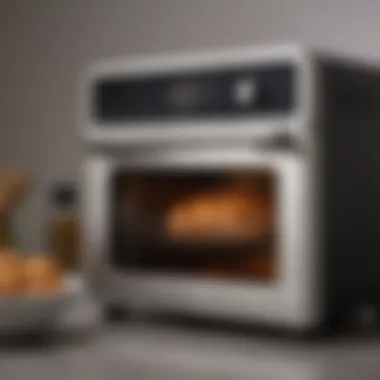
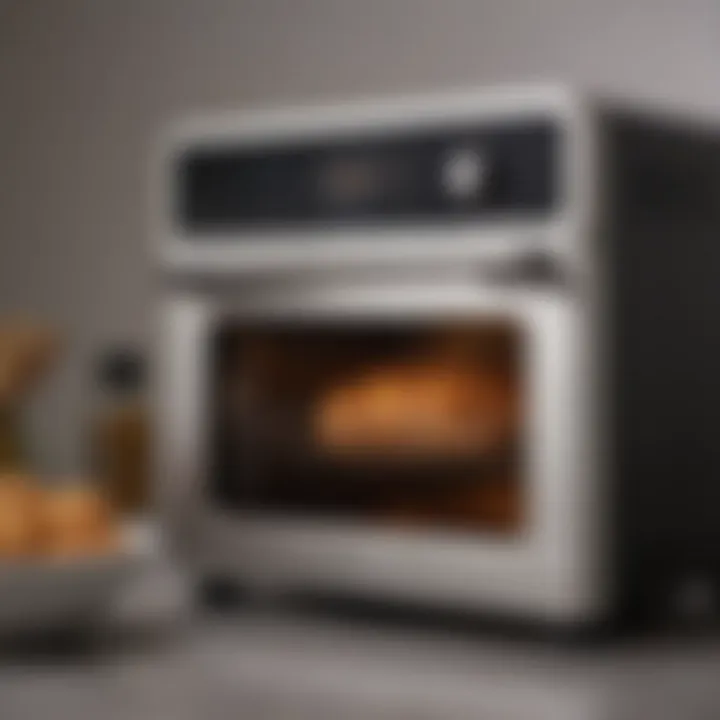
Intro
Air fryer ovens have gained tremendous popularity lately. They promise healthier cooking options while maintaining delicious flavors. This guide aims to dissect the best air fryer ovens on the market today. We will explore their features, benefits, and practical uses. Moreover, the discussion will cover various technologies, comparisons of leading models, and unique cooking techniques tied to air frying.
Understanding these appliances can enhance your culinary experiences significantly. Many homeowners and cooking enthusiasts tend to overlook the critical specifications when selecting an air fryer oven. This guide serves not only to illuminate the landscape of options available but to provide practical advice for making informed decisions regarding an air fryer oven purchase.
Let’s delve deeper into the essential aspects of choosing the right air fryer oven.
Intro to Air Fryer Ovens
Air fryer ovens have emerged as a significant kitchen appliance in recent years. Their capacity to cook food quickly and more healthily compared to traditional frying methods makes them appealing to a wide range of users. Notably, air fryers use hot air circulation technology to create a crispy texture similar to that of fried food, without the excessive use of oil. This shift towards more health-conscious cooking aligns with current dietary trends, making it an important topic in today’s culinary landscape.
Understanding air fryer ovens allows homeowners and cooking enthusiasts to appreciate their versatility and efficiency in meal preparation. Familiarity with how they function can lead to better cooking practices. For instance, air fryer ovens often come with multiple cooking functions including baking, roasting, and grilling. This multifunctionality saves both time and space in the kitchen.
Moreover, an increasing number of studies indicate that air frying can preserve nutritional values better than some conventional cooking methods. This added benefit can appeal to health-conscious individuals seeking to maintain a balanced diet without compromising on taste.
When considering a purchase, it is essential to assess various factors such as size, capacity, and features specific to the appliance. This exploration into air fryer ovens tells prospective buyers what to look for and ensures they can make educated decisions based on their unique cooking needs and lifestyles.
Key insights about air fryer ovens include:
- Healthier cooking options
- Time-efficient meal preparation
- Versatile cooking functions that cater to different recipes.
The Evolution of Air Frying Technology
The evolution of air frying technology is paramount in understanding the best air fryer ovens available today. It reflects significant shifts in cooking methods aimed at improving health and convenience. The transition from traditional frying to air frying demonstrates how consumer needs and dietary trends have shaped kitchen technology. This section explores historical roots and key advancements in this culinary tool, which ultimately enhances the home cooking experience for many.
Historical Context
Air frying technology finds its roots in efforts to create healthier cooking options. Traditional frying methods often involve large amounts of oil, presenting health concerns. The concept of air frying emerged as a solution to this problem, enabling users to achieve crisp textures without bathing food in oil.
The first air fryers appeared in the early 2000s, capitalizing on convection cooking techniques. They utilized hot air circulation to create that desired crispiness. This innovation gradually gained popularity as concerns over obesity and health conditions surged. Consumers began seeking methods to reduce fat intake while still enjoying fried foods. Notably, products like the Philips Airfryer first sparked widespread interest, leading to many variations and improvements in design.
Technological Advancements
Technological advancements have played a crucial role in refining air fryer ovens into high-performance appliances. The initial models were basic, often lacking in versatility and efficiency. Today's air fryers, however, have undergone remarkable changes. Modern models feature advanced heating elements and fan designs that ensure even heat distribution, leading to consistent cooking results.
Recent generations of air fryers include multifunctional capabilities, allowing users to bake, roast, and grill. This versatility is achieved through innovations such as digital controls, preset cooking programs, and temperature settings, which take the guesswork out of cooking. Additionally, materials used have improved, leading to easier cleaning and enhanced durability. Overall, advancements in air fryer technology represent a fusion of convenience, efficiency, and health consciousness that continues to appeal to an increasingly health-aware public.
"The evolution of air frying technology is not just about cooking. It's about changing the way we approach meals and making healthier choices easier than ever."
In understanding the evolution of air frying technology, readers gain insight into the implications for their cooking habits. As awareness of health continues to rise, and technology evolves further, the air fryer remains a key player in home kitchens.
Key Features of Air Fryer Ovens
Understanding the key features of air fryer ovens is crucial for homeowners and culinary enthusiasts looking to enhance their cooking capabilities. These appliances offer various functionalities that cater to diverse cooking needs. Knowing these features helps consumers make informed decisions tailored to their lifestyle and preferences.
Size and Capacity
When selecting an air fryer oven, the size and capacity are fundamental considerations. Air fryers come in different sizes, affecting both their cooking capacity and the amount of counter space they consume. A compact air fryer may be suitable for a small kitchen or limited cooking needs, whereas larger models can accommodate meals for families or entertaining events.
Most air fryers range from 2 to 6 quarts, determining how much food you can prepare at one time. For example, a 4-quart air fryer can typically serve 3 to 5 people, making it ideal for family dinners. Larger models may be advantageous for hosting gatherings, allowing for multiple dishes to be prepared simultaneously. However, it is essential to balance capacity with the available kitchen space since bulkier models may become cumbersome in smaller areas.
Cooking Functions
Air fryers are not merely for frying foods. They often come equipped with multiple cooking functions including baking, roasting, grilling, and toasting. This versatility makes them an attractive addition to modern kitchens, offering the ability to experiment with various dishes. For instance, a model with a baking function can help create muffins or cakes, expanding the range of possible meals.
Some advanced air fryers include preset functions, which automate cooking times and temperatures. This assists novice cooks in achieving optimal results without extensive culinary expertise. For those with dietary restrictions or preferences, customizable settings enable users to tailor cooking processes to specific necessities, contributing to healthier meal options.
Heating Technology
The heating technology utilized in air fryer ovens affects not only cooking performance but also energy efficiency. Most modern air fryers use Rapid Air Technology that circulates hot air around the food at high speeds. This method allows for even cooking and can create a crisp texture akin to traditional frying with less oil.
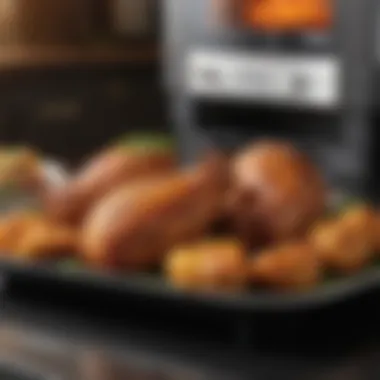
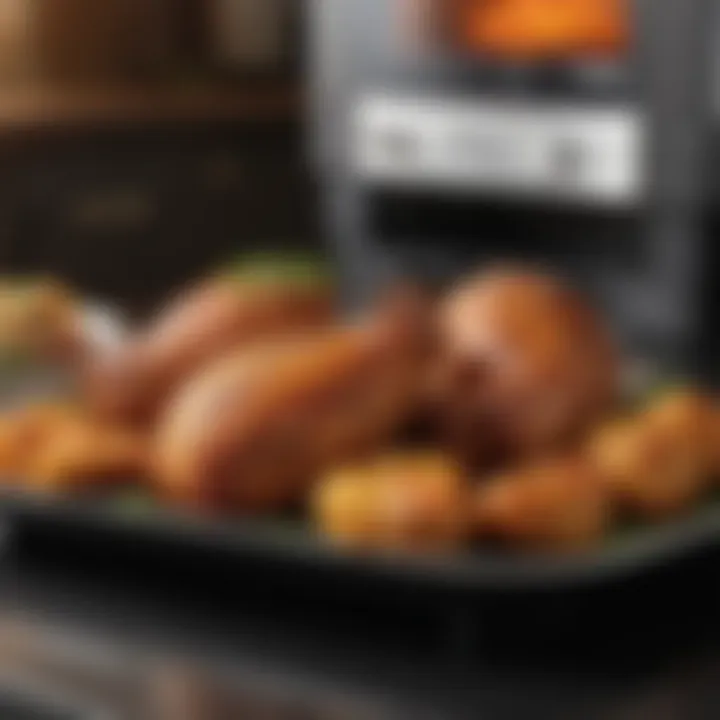
Another key point is the use of convection heating elements. Models that incorporate both conventional heating elements and hot air circulation often achieve faster cooking times and better heat distribution. Consequently, understanding the technology behind cooking will aid in selecting the best air fryer for individual cooking styles.
Evaluating Cooking Performance
Evaluating cooking performance is crucial when choosing an air fryer oven. The performance directly affects the quality of the food prepared. Key indicators such as crispness and evenness of cooking provide insight into how well an air fryer oven fulfills its primary function—cooking with precision and yielding desirable outcomes.
An effective air fryer should replicate the frying techniques typically achieved through traditional frying methods while offering healthier alternatives. Understanding its cooking performance helps consumers identify which model best suits their culinary needs.
Crispness Comparison with Traditional Methods
One of the primary benefits of air frying is the ability to achieve that satisfying crispness expected from fried foods. When comparing air fryer ovens to traditional frying methods, the differences can be quite pronounced. Air fryers use a fan to circulate hot air around the food, creating a crispy exterior without the need for substantial oil. This technology can produce a texture similar to deep-frying but with significantly less fat.
In terms of crispiness, many users find that air fryers can achieve comparable results for a variety of foods, including fries, chicken, and vegetables. Several tests reveal that foods cooked in an air fryer might not replicate the exact frying texture; however, they often come close. Key considerations include:
- Oil Usage: Traditional frying typically requires a significant amount of oil, which can impact flavor and health. Air fryers often need only a light spray or none at all, allowing for a guilt-free cooking experience.
- Texture Variability: Different brands and models might vary in how well they achieve crispness. Users should research reviews and consider which model best meets their expectations for texture.
- Food Selection: Some foods naturally fry better than others. For instance, potato products may retain more crispness in an air fryer compared to items like breaded fish, which may require experimentation to perfect.
"An air fryer provides a healthier way to enjoy crispy textures without the excess oil typical of traditional methods."
Evenness of Cooking
The evenness of cooking is another vital aspect when assessing an air fryer oven’s performance. Uneven cooking can lead to parts of the food being overcooked while others remain underdone, which is a common issue in appliances with insufficient heat distribution. An effective air fryer should exhibit consistent heat flow to ensure that food cooks evenly.
Several factors influence the evenness of cooking in air fryer ovens:
- Airflow Design: The design of the heating elements and the placement of the fan can affect how heat circulates. Ovens like the Philips Airfryer and Ninja Air Fryer are known for their effective hot air circulation.
- Food Arrangement: Properly spacing food within the basket helps maintain optimal airflow. Overcrowding can lead to uneven cooking, defeating the purpose of using an air fryer. It is recommended to cook in smaller batches to achieve the best results.
- Cookware Compatibility: Using the right accessories can also influence cooking evenness. Non-stick baking pans designed specifically for air fryers often help distribute heat better.
To ensure consistent results, users should familiarize themselves with their air fryer model. This includes the appropriate cooking times and temperatures for different foods.
In summary, evaluating cooking performance in air fryer ovens is essential for food enthusiasts looking for quality results. Crispness and evenness significantly impact the culinary experience, making these aspects worth considering thoroughly.
Current Leading Models in the Market
In understanding air fryer ovens, recognizing the current leading models in the market is pivotal. These models embody a combination of innovative technology and practical features, guiding potential buyers toward a purchase that best suits their culinary needs. This section examines various models that stand out due to their performance, efficiency, and user satisfaction. Analyzing these leading options aids in evaluating which stove may serve your lifestyle and cooking habits the best.
High-End Options
High-end air fryer ovens often provide cutting-edge technology and extensive features. Brands such as Breville, Cuisinart, and Philips have gained attention for their premium offerings. Breville BOV900BSS Smart Oven Air is one shining example, integrating air frying with multiple cooking functions, such as roasting and toasting. The build quality is solid, and it boasts a spacious interior, capable of handling large meals.
Many customers cite the ease of use as a crucial feature of high-end models. With presets for various foods, these ovens minimize the guesswork involved with cooking. They often come equipped with advanced heating technologies, ensuring food cooks evenly.
Budget-Friendly Choices
For those looking to save money, budget-friendly air fryer ovens are readily available. Models such as Cosori and Black+Decker are noted for their affordability without compromising on essential features.
Cosori Air Fryer Max XL is a popular choice among homeowners seeking balance between cost and performance. With a user-friendly interface and a capacity suitable for family meals, it offers good value. It also features presets for various food types, allowing versatility in cooking without an advanced knowledge of air frying.
Affordability does not mean a lack of quality. These options typically still provide decent power consumption and efficiency, catering well to individuals and families who want healthier cooking methods without a heavy investment.
Versatile Multifunction Air Fryers
Multifunction air fryers capture consumer interest due to their versatility in the kitchen. Models like the Ninja Foodi and Instant Pot Duo crisp are designed to perform multiple functions, combining air frying with pressure cooking, roasting, and baking.
The Ninja Foodi, for example, allows you to go beyond just air frying. It provides the option to pressure cook and then crisp food all in one appliance. This flexibility is significant for busy individuals and families, offering one solution to various cooking techniques.
Additionally, these models often feature user-friendly controls and presets, making them accessible for those new to air frying. Their ability to streamline meal preparation, while still delivering crispiness and flavor, places them at the forefront of contemporary kitchen appliances.
"Investing in a leading model can significantly enhance your overall cooking experience, combining functionality with ease of use."
Selecting the right air fryer oven involves a knowledge of current leading models. Understanding the distinction between high-end, budget-friendly, and multifunction options empowers consumers to make informed decisions reflecting their culinary needs.
Energy Efficiency Considerations

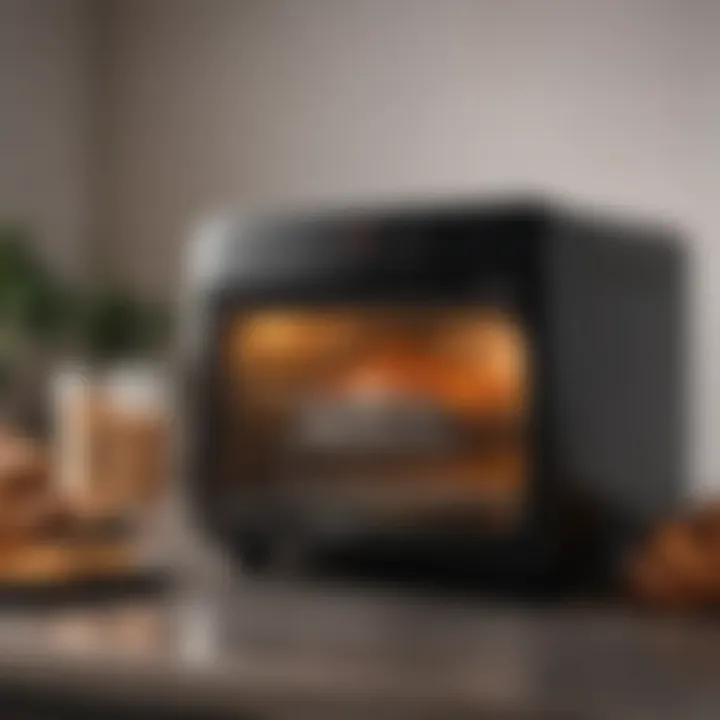
Energy efficiency is increasingly important in today’s world. As homeowners and consumers become more environmentally conscious, the choice of kitchen appliances plays a crucial role in energy consumption. Air fryer ovens are not only valued for their cooking capabilities but also for their ability to save energy. This section will discuss the key aspects of energy efficiency in air fryer ovens, emphasizing their importance in making an informed buying decision.
Power Consumption General Overview
Air fryer ovens generally consume less power than traditional ovens. On average, an air fryer oven uses about 1,200 to 2,000 watts of electricity, depending on the model and its functionalities. In comparison, conventional ovens may require anywhere from 2,000 to 5,000 watts. This difference in power consumption results in lower energy costs over time.
The compact design of air fryers allows them to heat up more quickly than their larger counterparts, reducing overall cooking time. For everyday cooking, this efficiency translates into tangible savings. Moreover, many air fryer models come with energy-efficient settings that further optimize power usage.
"Choosing an air fryer not only enhances your cooking experience but also helps you save on energy bills over time."
Cost-Effectiveness in the Long Run
Investing in an air fryer oven can lead to significant savings in the long run, particularly regarding energy bills. Given that air fryers cook food faster, they reduce the amount of time the appliance is on, thus lowering energy consumption. Additionally, the ability to prepare healthier meals with less oil may lead to savings on grocery bills over time.
Consider the maintenance costs as well. Air fryers often require less energy to operate, and many are equipped with self-cleaning features or materials that are easy to maintain.
When comparing costs, it’s essential to assess the initial investment in an air fryer oven versus potential savings on energy bills and food costs. A quality air fryer can pay for itself through energy efficiency and reduced cooking times, making it a prudent choice for conscious consumers. As energy prices fluctuate, having an energy-efficient appliance can cushion against rising household costs.
Safety Features to Look For
When considering the best air fryer ovens, safety features play a crucial role in ensuring not only the efficiency of your cooking process but also your well-being at home. Understanding these features assists users in selecting a unit that minimizes risks. Air fryer ovens, while designed with convenience in mind, can pose hazards if not equipped with proper safety mechanisms. Buyers should be attuned to the essential aspects that contribute to a safer cooking experience.
Heat Resistance and Design
A vital safety feature in air fryer ovens is heat resistance. The exterior design must incorporate materials that do not retain heat excessively, reducing the risk of burns during operation. Most modern air fryers utilize heat-resistant plastics or metals that can withstand high temperatures, keeping the surface cooler to touch. Reliable brands ensure that components like handles and housing remain relatively cool, even when the appliance is in full operation.
Additionally, the overall layout should prevent accidental contact with hot surfaces and minimize the chance of tipping over. A solid design with a stable base and ergonomic handles can significantly enhance safety. Users should check for specific heat resistance ratings, as these indicate how well the appliance can dissipate heat.
Automatic Shut-off Options
Another key element to consider is the automatic shut-off option. This feature serves as a critical safeguard against overheating or overcooking. When activated, an air fryer oven with this function will cease operation after a set period or if it detects that food has finished cooking. This is especially beneficial for busy households where distractions can lead to forgetting an appliance in use.
The presence of this feature not only aids in preventing kitchen mishaps but also promotes energy efficiency by ensuring that the device does not run longer than necessary. Cookers equipped with this feature often include indicators that signal when the appliance has shut off.
In summary, assessing the safety features of air fryer ovens is essential. Heat resistance and automatic shut-off options significantly enhance user comfort and protection. A well-thought-out selection based on these elements ensures a better cooking experience and peace of mind.
User Experience and Maintenance
In the context of air fryer ovens, user experience and maintenance are paramount for both new and seasoned cooks. A kitchen appliance must offer ease of use, reliability, and straightforward upkeep to maintain its place in your cooking routine. Understanding these elements ensures that you not only make the right choice when purchasing, but also enjoy using the appliance day after day.
Ease of Use
An air fryer oven should ideally have an intuitive interface that simplifies the cooking process. Features like digital displays, pre-programmed settings, and adjustable timers contribute to the user-friendliness of the appliance. When choosing an air fryer oven, consider the following aspects:
- Control Panel: Look for a control panel that is intuitive. Buttons should be clearly labeled, and navigation through settings should be straightforward.
- Cooking Presets: Models with built-in presets allow you to cook common dishes like fries or chicken wings without guesswork. This is particularly helpful for those who may be less confident in the kitchen.
- Visual Indicators: Features like preheating alerts and cooking completion signals enhance the cooking experience. You should feel confident that your meal is being prepared correctly.
The more a user-friendly design enhances your confidence in utilizing the air fryer oven, the more often you will use it. Simplifying meal preparation leads to a more enjoyable cooking process overall.
Cleaning and Care Requirements
Maintaining an air fryer oven is crucial for longevity and performance. Regular cleaning helps prevent the buildup of grease and food particles, ensuring that each meal is prepared in a hygienic environment. Consider these cleaning requirements:
- Removable Components: Many air fryer ovens have detachable parts such as trays and baskets that can be easily cleaned. Opt for models with non-stick surfaces to make cleanup more efficient.
- Dishwasher Safe: Some components are dishwasher safe, which can save time and effort. Checking for this feature can significantly change how you integrate the device into your routine.
- Routine Maintenance: Besides cleaning after every use, it’s advisable to conduct a deeper clean periodically. This includes checking heating elements for any residue and ensuring the ventilation system is clear of obstructions. A well-maintained oven will function better and provide consistent results.
"Regular cleaning not only helps maintain functionality but also ensures optimal cooking performance every time you use your air fryer oven."
When you account for ease of use and maintenance in an air fryer oven, you set the foundation for an enjoyable cooking experience that can keep you engaged and satisfied with your kitchen endeavors. Choosing a model that prioritizes these factors allows you to focus on crafting delicious meals, rather than struggling with technical difficulties or messy cleanups.
Comparative Analysis with Conventional Ovens
Understanding the comparative aspects between air fryer ovens and conventional ovens is essential for those seeking to upgrade their cooking methods. This analysis highlights differences in cooking time, energy efficiency, and health benefits, providing a clearer perspective for homeowners, interior design enthusiasts, and hosts.


Cooking Time Efficiency
One of the most significant advantages of air fryer ovens is their cooking time efficiency. With faster preheating and cooking capabilities, air fryer ovens considerably reduce meal preparation time. The rapid air technology circulates hot air quickly around food, enabling cooking at higher speeds compared to traditional methods.
Here are a few key benefits of this efficiency:
- Reduced Preheating Time: Conventional ovens often require preheating, which can waste valuable time. Air fryers reach cooking temperature quickly, making spontaneous cooking easier.
- Faster Cooking: Recipes that typically take an hour in a conventional oven can often be completed in under thirty minutes with an air fryer. This rapid cooking process is beneficial for busy lifestyles.
- Batch Cooking: The compact size of many air fryers allows for cooking multiple batches of different food items without significant downtime, further enhancing efficiency.
In fact, research suggests that air fryers can reduce cooking time by up to 25% when compared to conventional ovens.
Nutritional Impacts of Air Frying
Health-conscious individuals might favor air frying due to its reduced fat content compared to traditional frying and even baking. The air frying process permits the use of significantly less oil, while still achieving desirable textures.
- Lower Oil Usage: Air fryers often require just a tablespoon or less of oil for frying, greatly reducing the overall caloric intake associated with deep-fried foods. The results still mimic the crispiness of deep-fried items.
- Retention of Nutrients: Shorter cooking times can also result in better nutrient retention. Some vitamins, particularly B vitamins and vitamin C, are sensitive to heat and prolonged cooking times.
- Less Heterocyclic Amines (HCAs): Air frying results in lesser formation of HCAs, which are compounds linked to high heat cooking methods like grilling or frying in a standard oven.
"The reliance on less oil leads to meals that are not only quicker to prepare but also more aligned with contemporary dietary preferences."
Culinary Techniques Exclusive to Air Fryers
Understanding the culinary techniques that are unique to air fryers is essential. These methods can enhance not only the flavor but also the overall cooking experience. The air fryer enables various cooking techniques that might not be achievable through other means. For instance, air frying itself involves circulating hot air around the food, producing a crispy outer layer while maintaining moisture inside. This method can significantly reduce cooking time compared to conventional ovens.
The significance of these techniques extends beyond just convenience. They can result in healthier meals due to the reduced need for oil, allowing home cooks to enjoy fried-like textures in food with less fat and fewer calories. Additionally, the versatility of air fryers means that users can explore a variety of cooking styles. This flexibility caters to different dietary needs and preferences, making it a valuable tool in any kitchen.
Unique Recipes and Cooking Styles
Unique recipes tailored for air fryers can transform everyday meals. Air fryers lend themselves well to various cooking styles, including roasting, baking, and grilling. Popular recipes include air-fried vegetables and protein options like chicken. The rapid air technology allows for even cooking, leading to better texture and flavor profiles.
Key considerations when creating recipes include:
- Timing: Since air fryers cook food faster, adjusting the cooking time is crucial.
- Temperature: It is often necessary to lower the cooking temperature compared to traditional methods.
- Preparation: For items like breaded chicken, consider handling to ensure the coating adheres well during cooking.
"Air frying is not just about replicating fried food; it's about enhancing flavors while preserving better health."
These elements create an exciting cooking environment that invites experimentation. Users can try out various ingredients and adapt their favorite recipes to fit the air fry technology.
Adjusting Recipes for Air Frying
Adjusting traditional recipes for air frying is a common practice. It involves understanding how air fryers differ from conventional methods. One main aspect is cooking time; recipes usually require a reduction in time when moving to an air fryer. As a general guideline, recipes generally need to be adjusted by about 20-30% shorter cooking time.
Another consideration is the use of fats. Air fryers rely on minimal oil for achieving the desired crispiness. Therefore, reducing or even eliminating the amount of fat in recipes can lead to healthier dishes. When baking in the air fryer, it's essential to choose appropriate bakeware, as some materials may not be suitable for the high heat and rapid air circulation.
To successfully adjust recipes:
- Test cooking times regularly until familiar with the specific model.
- Keep a close eye on the initial batches to avoid overcooking.
- Experiment with seasonings and marinades, as air frying can amplify flavors.
By following these tips, home cooks can efficiently transition to air frying while retaining the essence of their favorite recipes.
Finale and Final Recommendations
In wrapping up this comprehensive guide, it is essential to distill the key insights surrounding air fryer ovens. The information presented aims to empower readers with actionable knowledge that can significantly influence their purchasing decisions and enhance culinary practices at home. Recognizing the importance of air fryer ovens in modern kitchens, this conclusion encapsulates best practices for selection as well as glimpses into future trends in the technology.
Understanding the unique features and functionalities of air fryer ovens allows consumers to make well-informed choices. For instance, knowing the different cooking capacities, power consumption, and fundamental safety features can help homeowners select a model that suits their specific needs. Practical user experiences and maintenance insights lend further clarity as potential users evaluate their options.
"Choosing the right air fryer oven can transform your approach to cooking, as it combines convenience with healthier food preparation methods."
Best Practices in Selecting an Air Fryer Oven
Selecting the right air fryer oven involves considering multiple factors. Firstly, size and cooking capacity are paramount. A larger unit may be necessary for families or frequent entertainers, while a compact model could suffice for individuals or couples. Next, consider the range of cooking functions. Many air fryers offer settings for roasting, baking, and grilling, making them versatile tools in the kitchen. Look for ovens that provide adjustable temperature controls and timers for fine-tuning cooking results.
In addition to functionality, energy efficiency should not be overlooked. Models with high energy ratings generally consume less power, leading to lower electricity bills over time. Finally, explore customer reviews and feedback. They often highlight real-world performance and reliability, which can inform potential buyers of any pitfalls.
Future Trends in Air Fryer Technology
As technology advances, air fryer ovens are likely to evolve further. One trend is the integration of smart technology. Wi-Fi-enabled models could allow users to control cooking remotely and receive notifications when meals are ready. This technological shift aligns with the growing popularity of smart kitchens, where convenience and efficiency are paramount.
Moreover, advancements in cooking technology may lead to even healthier options. For example, air fryers may incorporate new methods of cooking that retain more nutrients compared to traditional frying.
Lastly, an increased emphasis on sustainability might drive the design of air fryers towards eco-friendlier materials and energy-efficient systems. As consumers become more environmentally conscious, manufacturers may respond accordingly, shaping the future of air fryer technology with an eye towards reducing environmental impact.



